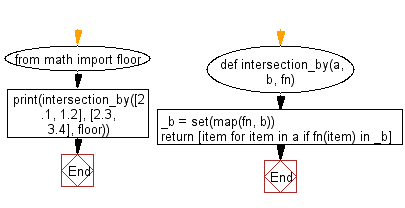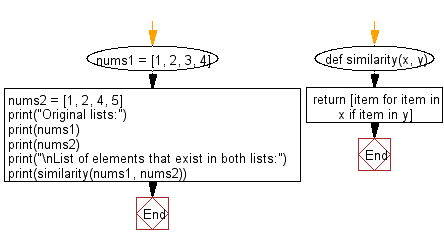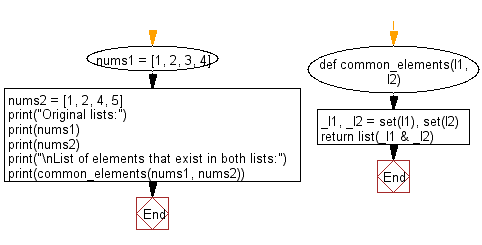Python: Get a list of elements that exist in both lists
Common Elements with Function
Write a Python program to get a list of elements that exist in both lists, after applying the provided function to each list element of both.
- Create a set, using map() to apply fn to each element in b.
- Use a list comprehension in combination with fn on a to only keep values contained in both lists.
Sample Solution-1:
Applying a given function:
Python Code:
# Import the necessary modules and functions.
from math import floor
# Define a function 'intersection_by' that takes two lists 'a' and 'b' and a function 'fn' as input.
def intersection_by(a, b, fn):
# Create a set '_b' containing the results of applying 'fn' to each element in list 'b'.
_b = set(map(fn, b))
# Return a list containing elements from list 'a' where 'fn(item)' is in the set '_b'.
return [item for item in a if fn(item) in _b]
# Provide an example of using 'intersection_by' function to find the intersection of two lists using 'floor' function as the key.
print(intersection_by([2.1, 1.2], [2.3, 3.4], floor))
Sample Output:
[2.1]
Flowchart:

Sample Solution-2:
Without applying any function:
Use a list comprehension on x to only keep values contained in both lists.
Python Code:
# Define a function 'similarity' that takes two lists 'x' and 'y' as input.
def similarity(x, y):
# Return a list containing elements from list 'x' that also exist in list 'y'.
return [item for item in x if item in y]
# Define two lists 'nums1' and 'nums2'.
nums1 = [1, 2, 3, 4]
nums2 = [1, 2, 4, 5]
# Display a message and the original lists.
print("Original lists:")
print(nums1)
print(nums2)
# Display a message and the list of elements that exist in both lists using the 'similarity' function.
print("\nList of elements that exist in both lists:")
print(similarity(nums1, nums2))
Sample Output:
Original lists: [1, 2, 3, 4] [1, 2, 4, 5] List of elements that exist in both lists: [1, 2, 4]
Flowchart:

Sample Solution-3:
Without applying any function:
- Create a set from a and b.
- Use the built-in set operator & to only keep values contained in both sets, then transform the set back into a list.
Python Code:
# Define a function 'common_elements' that takes two lists 'l1' and 'l2' as input.
def common_elements(l1, l2):
# Convert 'l1' and 'l2' into sets to eliminate duplicate values.
_l1, _l2 = set(l1), set(l2)
# Find the intersection (common elements) between the sets and convert it back to a list.
return list(_l1 & _l2)
# Define two lists 'nums1' and 'nums2'.
nums1 = [1, 2, 3, 4]
nums2 = [1, 2, 4, 5]
# Display a message and the original lists.
print("Original lists:")
print(nums1)
print(nums2)
# Display a message and the list of elements that exist in both lists using the 'common_elements' function.
print("\nList of elements that exist in both lists:")
print(common_elements(nums1, nums2))
Sample Output:
Original lists: [1, 2, 3, 4] [1, 2, 4, 5] List of elements that exist in both lists: [1, 2, 4]
Flowchart:

For more Practice: Solve these Related Problems:
- Write a Python program to get the common elements between two lists after converting all string elements to uppercase.
- Write a Python program to find common elements between two lists using a custom function that extracts a numeric field from dictionary elements.
- Write a Python program to compute the intersection of two lists after applying a function that rounds float values to one decimal place.
- Write a Python program to filter two lists with a provided function and then return the common elements that satisfy the condition.
Go to:
Previous: Write a Python program to retrieve the value of the nested key indicated by the given selector list from a dictionary or list.
Next: Write a Python program to get the symmetric difference between two lists, after applying the provided function to each list element of both.
Python Code Editor:
What is the difficulty level of this exercise?
Test your Programming skills with w3resource's quiz.
